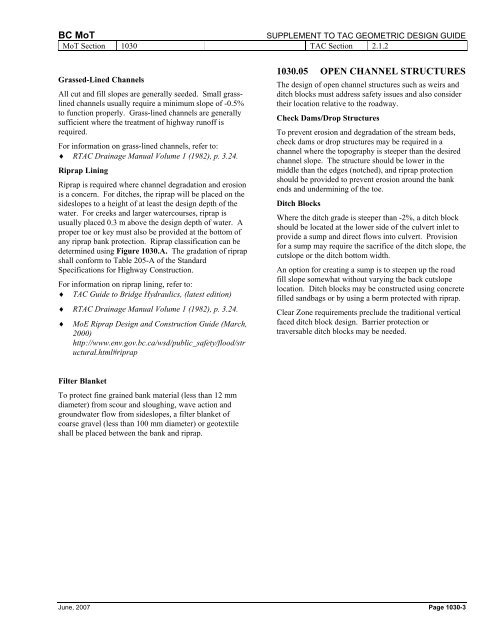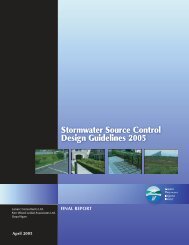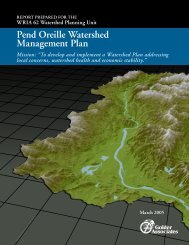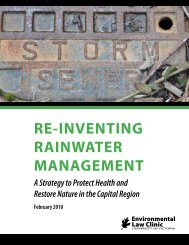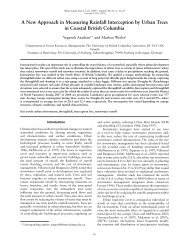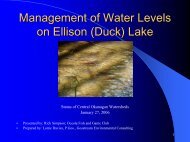1000 Hydraulics Chapter - Ministry of Transportation
1000 Hydraulics Chapter - Ministry of Transportation
1000 Hydraulics Chapter - Ministry of Transportation
Create successful ePaper yourself
Turn your PDF publications into a flip-book with our unique Google optimized e-Paper software.
BC MoT<br />
SUPPLEMENT TO TAC GEOMETRIC DESIGN GUIDE<br />
MoT Section 1030 TAC Section 2.1.2<br />
Grassed-Lined Channels<br />
All cut and fill slopes are generally seeded. Small grasslined<br />
channels usually require a minimum slope <strong>of</strong> -0.5%<br />
to function properly. Grass-lined channels are generally<br />
sufficient where the treatment <strong>of</strong> highway run<strong>of</strong>f is<br />
required.<br />
For information on grass-lined channels, refer to:<br />
♦ RTAC Drainage Manual Volume 1 (1982), p. 3.24.<br />
Riprap Lining<br />
Riprap is required where channel degradation and erosion<br />
is a concern. For ditches, the riprap will be placed on the<br />
sideslopes to a height <strong>of</strong> at least the design depth <strong>of</strong> the<br />
water. For creeks and larger watercourses, riprap is<br />
usually placed 0.3 m above the design depth <strong>of</strong> water. A<br />
proper toe or key must also be provided at the bottom <strong>of</strong><br />
any riprap bank protection. Riprap classification can be<br />
determined using Figure 1030.A. The gradation <strong>of</strong> riprap<br />
shall conform to Table 205-A <strong>of</strong> the Standard<br />
Specifications for Highway Construction.<br />
For information on riprap lining, refer to:<br />
♦ TAC Guide to Bridge <strong>Hydraulics</strong>, (latest edition)<br />
♦ RTAC Drainage Manual Volume 1 (1982), p. 3.24.<br />
♦<br />
MoE Riprap Design and Construction Guide (March,<br />
2000)<br />
http://www.env.gov.bc.ca/wsd/public_safety/flood/str<br />
uctural.html#riprap<br />
1030.05 OPEN CHANNEL STRUCTURES<br />
The design <strong>of</strong> open channel structures such as weirs and<br />
ditch blocks must address safety issues and also consider<br />
their location relative to the roadway.<br />
Check Dams/Drop Structures<br />
To prevent erosion and degradation <strong>of</strong> the stream beds,<br />
check dams or drop structures may be required in a<br />
channel where the topography is steeper than the desired<br />
channel slope. The structure should be lower in the<br />
middle than the edges (notched), and riprap protection<br />
should be provided to prevent erosion around the bank<br />
ends and undermining <strong>of</strong> the toe.<br />
Ditch Blocks<br />
Where the ditch grade is steeper than -2%, a ditch block<br />
should be located at the lower side <strong>of</strong> the culvert inlet to<br />
provide a sump and direct flows into culvert. Provision<br />
for a sump may require the sacrifice <strong>of</strong> the ditch slope, the<br />
cutslope or the ditch bottom width.<br />
An option for creating a sump is to steepen up the road<br />
fill slope somewhat without varying the back cutslope<br />
location. Ditch blocks may be constructed using concrete<br />
filled sandbags or by using a berm protected with riprap.<br />
Clear Zone requirements preclude the traditional vertical<br />
faced ditch block design. Barrier protection or<br />
traversable ditch blocks may be needed.<br />
Filter Blanket<br />
To protect fine grained bank material (less than 12 mm<br />
diameter) from scour and sloughing, wave action and<br />
groundwater flow from sideslopes, a filter blanket <strong>of</strong><br />
coarse gravel (less than 100 mm diameter) or geotextile<br />
shall be placed between the bank and riprap.<br />
June, 2007 Page 1030-3


